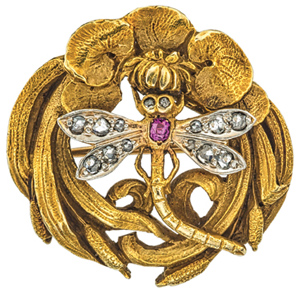|
Legacy
The Manzian Touch
The great-granddaughter of Gustav Manz is spotlighting the designs he created for some of the most prestigious jewelry houses during a half-century career.
By Phyllis Schiller

|
| Diamond and pink tourmaline handwrought gold dragonfly brooch by Gustav Manz, circa 1900 to 1905. |
Laura Mathews grew up with the knowledge that her great-grandfather Gustav Manz (1865-1946) had been a working jeweler. After being contacted by a graduate student writing an article about Manz’s career, she decided to take a closer look at his body of work. A magazine editor, Mathews was no stranger to doing research, only this time she had a much more personal subject to pursue. Along with prized family scrapbooks and anecdotes, she was able to examine Manz’s business records housed at the Winterthur Museum in Delaware. The meticulously detailed drawings, notations on materials, production records and lists of clients cover 15 years that were “a primary time in Manz’s career,” according to Mathews.
Designer, goldsmith and manufacturing jeweler, Manz was born in Germany near the major jewelry manufacturing center of Pforzheim. After apprenticing to a jeweler, Manz found there was no work locally and instead, in the late 1870s, says Mathews, “went wandering.” He ended up in South Africa, where he worked in the diamond industry. From there, he went to Paris, London and finally arrived in New York in 1892. Along the way, he was exposed to a wealth of design ideas. Setting up a workshop with a partner in Union Square, he did business as a sculptor and independent jeweler.
In 1899, Manz married Martha Bachem, whose parents had also come to the U.S. from Germany and were in the jewelry trade. Manz went into partnership with his mother-in-law, Sophie Bachem, which continued after the couple divorced. In 1903, Manz joined with Walter P. McTeigue to form McTeigue, Manz & Co., billing themselves as “Makers of Fine Diamond and Carved Jewelry.” In 1910, Manz established his own studio, continuing his work for a host of jewelry powerhouses — including Tiffany & Co., Cartier, Marcus & Co., Black, Starr & Frost, Raymond C. Yard and J.E. Caldwell. Among Manz’s private clients were Chicago Arts & Crafts jeweler Elinor Klapp and sculptor Sally Farnham, the wife of Paulding Farnham, who designed for Tiffany.
Manz was a one-generation jeweler, Mathews notes, although his youngest daughter Doris worked as his traveling “saleswoman,” quite a daring job for a woman at the time. It is thanks to her that many of his business records were preserved.
In 1904, Manz produced 25 of F. Walter Lawrence’s pieces for the Louisiana Purchase Exposition in St. Louis — animal, floral and archaeological designs — and his name is listed in the catalog as the maker. Twenty years later, Manz was chosen as one of seven jewelers in a show on American Industrial Art at the Metropolitan Museum of Art in recognition, says Mathews, of his position as a “top manufacturer. The work exhibited was distinctly exotic, featuring Egyptian deities and Buddhas with overlapping jade ‘wings’ or mounted in lattice with pearls and pink beryls.”
Thanks to the 400 precisely drafted drawings and descriptions in Manz’s records, Mathews, along with her sister, Cuyler, has been able to identify many of his pieces. “I learned to look at the auction catalogs and spot things that looked very ‘Manzian.’” Then, she matched them to the drawings for confirmation.
While she describes the early process as “looking for a stickpin in a haystack,” Mathews was able to find leads by searching the archives of Manz’s clients, tracking down descendants of those clients and consulting leading estate jewelry dealers. What she found was that Manz would make several versions of a design, fine-tuned for specific clients but reflecting a recognizable design sensibility. For example, there are dozens of panther and snake rings in the Winterthur book, made in “different sizes and stones.”
Manz’s recognizable motifs, Mathews says, are naturalistic themes — “grapevines and dragonflies and mermaids and lotuses” — especially from 1910 through the 1920s. In the late 1920s, he created mountings for scarabs, “using Egyptian-style lapis and carnelian and all of the blues and reds and burnt orange colors so popular during the Jazz Age.”
Manz was also well known for his animal jewelry, incredibly detailed little sculptures that were “one of his signatures,” points out Mathews. The animals range from climbing bears to elephants, panthers and more fanciful dragons and griffons. In a 1926 article in Arts & Decoration magazine that profiled Manz’s career, “The illustrations,” says Matthews, “were scatter pins of diamond pavé animals, very popular at the time, that he was doing for Cartier and Udall & Ballou and Black, Starr & Frost.”
Later in his career, Manz turned more to patriotic and ecclesiastical work. He also worked on a few of the gems displayed in the House of Jewels exhibit at the 1939 New York World’s Fair. Manz retired in 1944.
Mathews and her sister have begun making some of Manz’s pieces, starting with his elephant bracelet, handmade by a goldsmith in New York. A portion of the price of each bracelet sold goes to Tusk, an organization that funds conservation projects in Africa.
With a career that spanned major twentieth-century design movements, Manz adapted to changing times, yet his work has a coherence, Mathews sums up. “His rings sit beautifully on the finger. They have the heaviness of the gold. So much of the beauty of his pieces is the metal itself and what he could do with it. He had his own formulas to create a certain patina. If I look very carefully at the chasing and swirls in a piece, I can see his touch; it speaks to me.”Article from the Rapaport Magazine - January 2015. To subscribe click here.
|
|